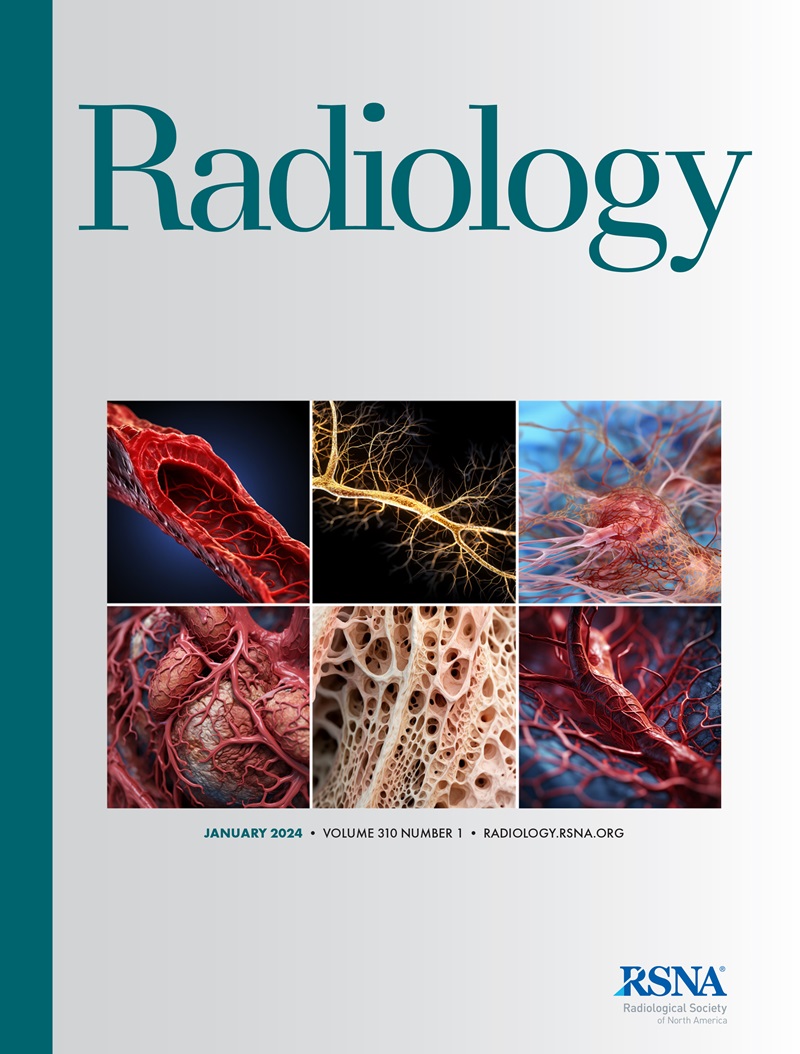Modulation of Cortical and Hippocampal Functional MRI Connectivity Following Transcranial Alternating Current Stimulation in Mild Alzheimer Disease.
IF 12.1
1区 医学
Q1 RADIOLOGY, NUCLEAR MEDICINE & MEDICAL IMAGING
Tao Wang, Shaozhen Yan, Yi Shan, Hanxiao Xue, Yi Xing, Sheng Bi, Zhigeng Chen, Hanyu Xi, Zhigang Qi, Yi Tang, Jie Lu
求助PDF
{"title":"Modulation of Cortical and Hippocampal Functional MRI Connectivity Following Transcranial Alternating Current Stimulation in Mild Alzheimer Disease.","authors":"Tao Wang, Shaozhen Yan, Yi Shan, Hanxiao Xue, Yi Xing, Sheng Bi, Zhigeng Chen, Hanyu Xi, Zhigang Qi, Yi Tang, Jie Lu","doi":"10.1148/radiol.241463","DOIUrl":null,"url":null,"abstract":"<p><p>Background Transcranial alternating current stimulation (tACS) may be effective for improving cognitive function in Alzheimer disease (AD), but its impact on brain functional connectivity (FC) has not been well studied. Purpose To evaluate tACS efficacy in improving cognitive performance and modulating FC between brain regions in individuals with AD using functional MRI. Materials and Methods In this prospective randomized controlled trial (September 2020 to April 2022), participants with mild AD were assigned to active (40 Hz tACS with 15-mA intensity) or sham (no γ frequency or current) tACS groups for 3 weeks (referred to as week 3), with a 3-month follow-up (referred to as month 3). Functional MRI and cognitive testing were performed at baseline, week 3, and month 3. Primary outcomes were changes in Mini-Mental State Examination and Montreal Cognitive Assessment scores from baseline to week 3. Secondary outcomes included FC changes within multiple cortical networks and between cortex and hippocampus from baseline to week 3 and month 3, assessed using Fisher <i>z</i>-transformed correlation coefficient (hereafter, <i>z</i> score). Results Forty-six participants were randomized into the active group (<i>n</i> = 23; median age, 66 years; IQR, 62-69 years; 16 female participants) or the sham group (<i>n</i> = 23; mean age, 64 years; IQR, 61-69 years; 14 female participants). The active group had higher Mini-Mental State Examination (median score change, 2 [IQR, 1-5] vs 0 [IQR, -1 to 2]; <i>P</i> = .001) and Montreal Cognitive Assessment (median score change, 2 [IQR, 0-4] vs 0 [IQR, -1 to 2]; <i>P</i> = .03) scores than the sham group at week 3, respectively. Compared with the sham group, the active group had increased FC between left hippocampus and left middle cingulate gyrus (<i>z</i> score difference, 0.29; 95% CI: 0.17, 0.42; false discovery rate [FDR]-adjusted <i>P</i> < .001) and between the left hippocampus and the left middle frontal gyrus (<i>z</i> score difference, 0.16; 95% CI: 0.03, 0.29; FDR-adjusted <i>P</i> = .04) within the posterior default-mode network (<i>z</i> score difference, 0.40; 95% CI: 0.07, 0.73; FDR-adjusted <i>P</i> = .046) and within the visual network (<i>z</i> score difference, 0.45; 95% CI: 0.17, 0.73; FDR-adjusted <i>P</i> = .007) from baseline to week 3. Conclusion Cognitive performance in mild AD improved following tACS, with increased FC within cortical networks and between the hippocampus and specific cortical regions. ClinicalTrials.gov Identifier: NCT03920826 © RSNA, 2025 <i>Supplemental material is available for this article.</i> See also the editorial by Shepherd in this issue.</p>","PeriodicalId":20896,"journal":{"name":"Radiology","volume":"315 3","pages":"e241463"},"PeriodicalIF":12.1000,"publicationDate":"2025-06-01","publicationTypes":"Journal Article","fieldsOfStudy":null,"isOpenAccess":false,"openAccessPdf":"","citationCount":"0","resultStr":null,"platform":"Semanticscholar","paperid":null,"PeriodicalName":"Radiology","FirstCategoryId":"3","ListUrlMain":"https://doi.org/10.1148/radiol.241463","RegionNum":1,"RegionCategory":"医学","ArticlePicture":[],"TitleCN":null,"AbstractTextCN":null,"PMCID":null,"EPubDate":"","PubModel":"","JCR":"Q1","JCRName":"RADIOLOGY, NUCLEAR MEDICINE & MEDICAL IMAGING","Score":null,"Total":0}
引用次数: 0
引用
批量引用
Abstract
Background Transcranial alternating current stimulation (tACS) may be effective for improving cognitive function in Alzheimer disease (AD), but its impact on brain functional connectivity (FC) has not been well studied. Purpose To evaluate tACS efficacy in improving cognitive performance and modulating FC between brain regions in individuals with AD using functional MRI. Materials and Methods In this prospective randomized controlled trial (September 2020 to April 2022), participants with mild AD were assigned to active (40 Hz tACS with 15-mA intensity) or sham (no γ frequency or current) tACS groups for 3 weeks (referred to as week 3), with a 3-month follow-up (referred to as month 3). Functional MRI and cognitive testing were performed at baseline, week 3, and month 3. Primary outcomes were changes in Mini-Mental State Examination and Montreal Cognitive Assessment scores from baseline to week 3. Secondary outcomes included FC changes within multiple cortical networks and between cortex and hippocampus from baseline to week 3 and month 3, assessed using Fisher z -transformed correlation coefficient (hereafter, z score). Results Forty-six participants were randomized into the active group (n = 23; median age, 66 years; IQR, 62-69 years; 16 female participants) or the sham group (n = 23; mean age, 64 years; IQR, 61-69 years; 14 female participants). The active group had higher Mini-Mental State Examination (median score change, 2 [IQR, 1-5] vs 0 [IQR, -1 to 2]; P = .001) and Montreal Cognitive Assessment (median score change, 2 [IQR, 0-4] vs 0 [IQR, -1 to 2]; P = .03) scores than the sham group at week 3, respectively. Compared with the sham group, the active group had increased FC between left hippocampus and left middle cingulate gyrus (z score difference, 0.29; 95% CI: 0.17, 0.42; false discovery rate [FDR]-adjusted P < .001) and between the left hippocampus and the left middle frontal gyrus (z score difference, 0.16; 95% CI: 0.03, 0.29; FDR-adjusted P = .04) within the posterior default-mode network (z score difference, 0.40; 95% CI: 0.07, 0.73; FDR-adjusted P = .046) and within the visual network (z score difference, 0.45; 95% CI: 0.17, 0.73; FDR-adjusted P = .007) from baseline to week 3. Conclusion Cognitive performance in mild AD improved following tACS, with increased FC within cortical networks and between the hippocampus and specific cortical regions. ClinicalTrials.gov Identifier: NCT03920826 © RSNA, 2025 Supplemental material is available for this article. See also the editorial by Shepherd in this issue.
轻度阿尔茨海默病经颅交流电刺激后皮质和海马功能MRI连通性的调节。
背景经颅交流电流刺激(tACS)可能有效改善阿尔茨海默病(AD)的认知功能,但其对脑功能连接(FC)的影响尚未得到很好的研究。目的应用功能MRI评价tACS改善AD患者认知能力和调节脑区间FC的疗效。在这项前瞻性随机对照试验(2020年9月至2022年4月)中,轻度AD患者被分配到积极(40 Hz, 15 ma强度的tACS)或假(无γ频率或电流)tACS组,为期3周(称为第3周),随访3个月(称为第3个月)。在基线、第3周和第3个月分别进行功能性MRI和认知测试。主要结果是从基线到第3周的迷你精神状态检查和蒙特利尔认知评估得分的变化。次要结局包括从基线到第3周和第3个月,多个皮质网络内以及皮质和海马之间的FC变化,使用Fisher z-转换相关系数(以下为z评分)进行评估。结果46例受试者随机分为积极组(n = 23;中位年龄66岁;62-69岁;16名女性参与者)或假手术组(n = 23;平均年龄64岁;IQR, 61-69岁;14名女性参与者)。积极组精神状态测试总分中位数变化为2 [IQR, 1-5]比0 [IQR, -1 ~ 2];P = .001)和蒙特利尔认知评估(中位评分变化,2 [IQR, 0-4] vs 0 [IQR, -1至2];P = 0.03)评分分别高于假手术组。与假手术组比较,活动组左海马和左扣带回中FC增加(z评分差,0.29;95% ci: 0.17, 0.42;错误发现率[FDR]校正P < .001)和左海马与左额叶中回之间的差异(z得分差,0.16;95% ci: 0.03, 0.29;经fdr调整的P = .04)在后验默认模式网络内(z得分差,0.40;95% ci: 0.07, 0.73;fdr校正P = 0.046)和视觉网络内(z评分差,0.45;95% ci: 0.17, 0.73;fdr校正P = .007)从基线到第3周。结论轻度AD患者的认知能力在tACS后得到改善,皮质网络内以及海马与特定皮质区域之间的FC增加。ClinicalTrials.gov标识符:NCT03920826©RSNA, 2025本文提供补充材料。参见Shepherd在本期的社论。
本文章由计算机程序翻译,如有差异,请以英文原文为准。

 求助内容:
求助内容: 应助结果提醒方式:
应助结果提醒方式:


